Petrochemical Engineering Financial Model
Financial Model for a Petrochemical Engineering Company
This very extensive 20 Year Petrochemical Engineering Company Model involves detailed revenue projections, cost structures, capital expenditures, and financing needs. This model provides a thorough understanding of the financial viability, profitability, and cash flow position of your business. Includes: 20x Income Statements, Cash Flow Statements, Balance Sheets, CAPEX sheets, OPEX Sheets, Statement Summary Sheets, and Revenue Forecasting Charts with the specified revenue streams, BEA charts, sales summary charts, employee salary tabs and expenses sheets. 140 Spreadsheets in 1 Excel Workbook giving a calculation of profitability for your Petrochemical Engineering Company.
Income Statement (Profit & Loss Statement)
A. Revenue
Product Sales Revenue
Ethylene, Propylene, Polyethylene, Methanol, etc.
Based on volume (metric tons) × average selling price (ASP)
Engineering/Service Contracts
Lump sum or milestone-based payments
By-product and Waste Sales
Trading Revenue (if any)
B. Cost of Goods Sold (COGS)
Raw Material Costs
Naphtha, Natural Gas, Crude Oil fractions
Utilities
Steam, electricity, water usage
Labor (Production Only)
Maintenance and Repairs
Depreciation (Production-related assets)
→ Gross Profit = Revenue – COGS
C. Operating Expenses (OPEX)
Selling, General & Administrative (SG&A)
Marketing, management salaries, legal, insurance
R&D Costs
Process innovation and catalyst development
Other Operating Expenses
Travel, audit, environmental compliance
Depreciation & Amortization (non-production)
→ EBITDA = Gross Profit – Operating Expenses (excl. D&A)
→ EBIT = EBITDA – Depreciation & Amortization
D. Other Income/Expenses
Interest Income / Expense
Exchange Rate Gains/Losses
Gains/Losses on Asset Sales
E. Taxes
Effective tax rate based on jurisdiction and incentives
F. Net Income
→ Net Income = EBIT – Interest – Taxes
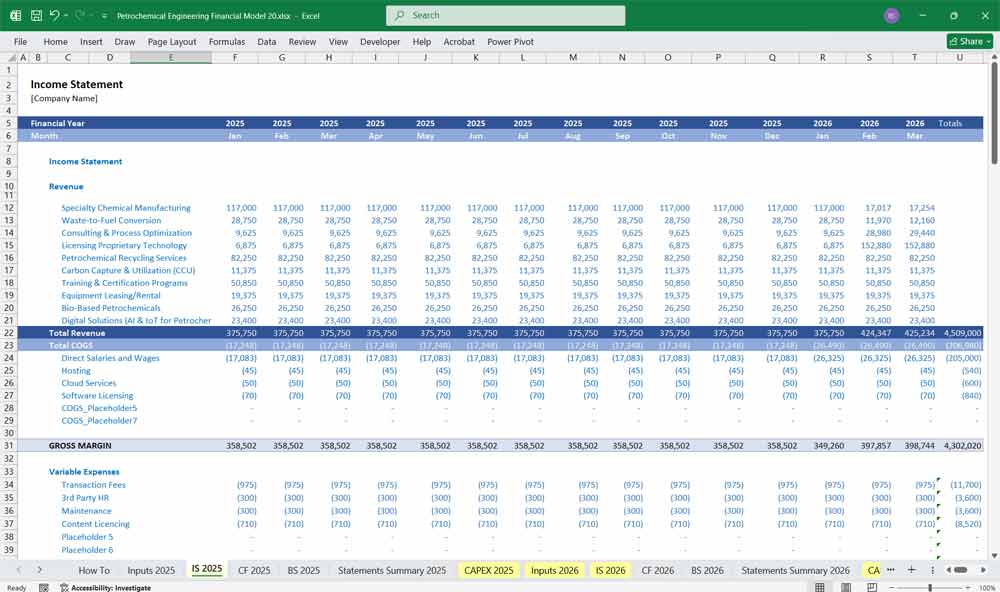
Petrochemical Engineering Company Cash Flow Statement
Organized into three major categories:
A. Cash Flow from Operating Activities
Net Income
Adjustments for Non-Cash Items
Depreciation & Amortization
Provision for environmental liabilities
Changes in Working Capital
Accounts Receivable
Inventory (raw materials, WIP, finished goods)
Accounts Payable
Prepaid Expenses and Accrued Liabilities
Deferred Taxes
→ Net Cash from Operating Activities
B. Cash Flow from Investing Activities
Capital Expenditures (CapEx)
Plant expansions
Equipment upgrades
Storage tanks and pipelines
Asset Sales
Sale of old equipment or non-core assets
Investments in JVs or New Projects
Intangible Asset Investments
Licenses, patents, technical know-how
→ Net Cash from Investing Activities
C. Cash Flow from Financing Activities
Debt Issuance / Repayment
Equity Issuance / Buybacks
Dividend Payments
Interest Paid
Lease Payments (if not part of OpEx)
→ Net Cash from Financing Activities
D. Net Cash Flow
= Operating + Investing + Financing Activities
E. Beginning and Ending Cash Balances
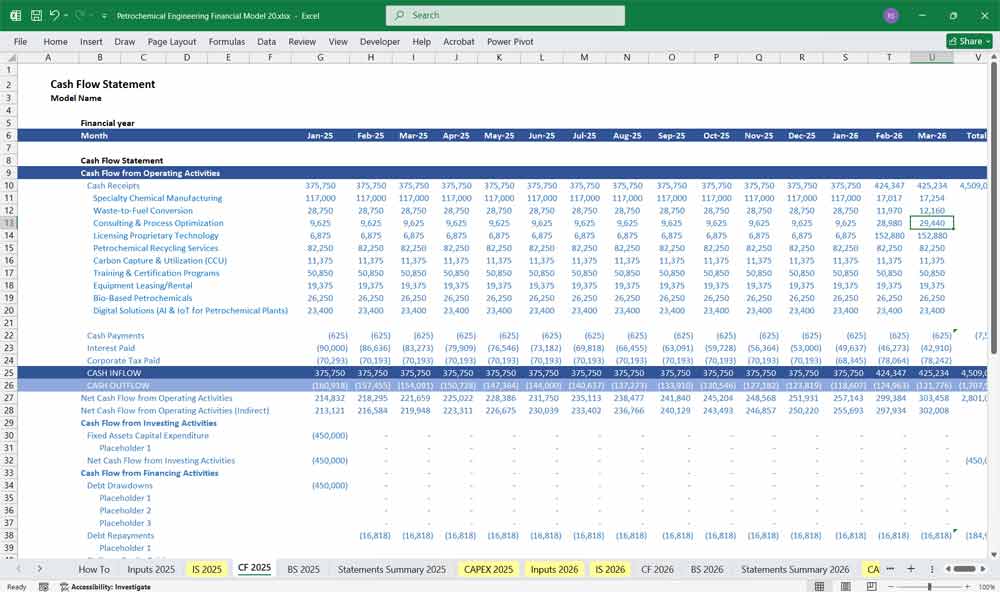
Petrochemical Engineering Company Balance Sheet
A snapshot of the company’s financial position.
A. Assets
1. Current Assets
Cash and Equivalents
Accounts Receivable
Inventory
Raw materials
Work-in-progress (WIP)
Finished goods
Prepaid Expenses
Other Short-Term Assets
2. Non-Current Assets
Property, Plant & Equipment (PP&E)
Petrochemical plants
Pipelines
Machinery & vehicles
Accumulated Depreciation
Capital Work in Progress (CWIP)
Intangible Assets
Licenses, patents, software
Long-term Investments
Deferred Tax Assets (if any)
B. Liabilities
1. Current Liabilities
Accounts Payable
Accrued Expenses
Short-Term Debt
Taxes Payable
Current Portion of Long-Term Debt
2. Non-Current Liabilities
Long-Term Debt
Lease Liabilities
Pension Liabilities
Decommissioning/Environmental Provisions
Deferred Tax Liabilities
C. Equity
Share Capital
Additional Paid-In Capital
Retained Earnings
Revaluation Reserves (if any)
Non-controlling Interest (in case of subsidiaries)
→ Assets = Liabilities + Equity
Supporting Schedules (optional but recommended)
Revenue Schedule: Volume × Price per product line
COGS Schedule: Linked to input prices and volumes
CapEx Schedule: Linked to project timelines
Debt Schedule: Opening balance, additions, repayments, interest
Depreciation Schedule: Asset classes and useful lives
Working Capital Schedule: DSO, DPO, Inventory Turnover
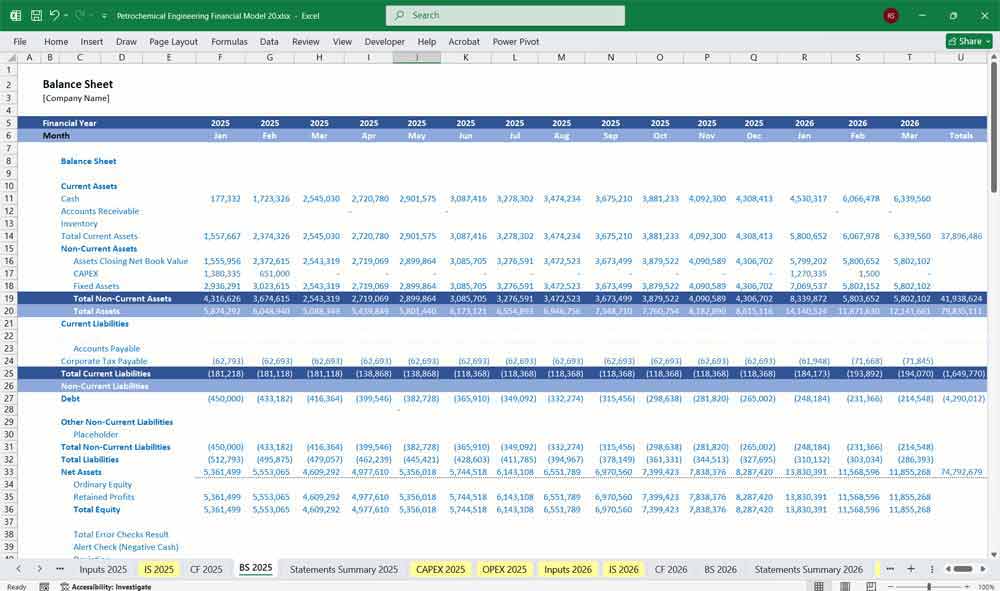
Example Revenues For A Petrochemical Manufacturing Company
1. Specialty Chemical Manufacturing
Produce high-value specialty chemicals (e.g., catalysts, additives, lubricants) for niche markets like pharmaceuticals, electronics, or renewable energy.
2. Waste-to-Fuel Conversion
Develop processes to convert petrochemical waste, plastics, or biomass into synthetic fuels (e.g., pyrolysis oil, biodiesel) and sell to refineries or energy companies.
3. Consulting & Process Optimization
Offer expert consulting services to refineries and chemical plants to improve efficiency, reduce emissions, and optimize production processes.
4. Licensing Proprietary Technology
Develop and license proprietary refining/petrochemical technologies (e.g., advanced catalysts, carbon capture systems) to other companies.
5. Petrochemical Recycling Services
Establish a business unit focused on recycling plastic waste into reusable petrochemical feedstocks (circular economy model).
6. Carbon Capture & Utilization (CCU)
Partner with energy firms to capture CO₂ emissions and convert them into useful products (e.g., methanol, polymers).
7. Training & Certification Programs
Offer specialized training courses, workshops, or certifications for petrochemical engineers and plant operators.
8. Petrochemical Equipment Leasing/Rental
Lease out specialized equipment (e.g., reactors, distillation columns, analyzers) to smaller firms that can’t afford full ownership.
9. Bio-Based Petrochemicals
Invest in R&D for bio-based alternatives (e.g., bio-plastics, green solvents) to cater to sustainability-focused industries.
10. Digital Solutions (AI & IoT for Petrochemical Plants)
Develop AI-driven predictive maintenance software, process automation tools, or IoT sensors for real-time plant monitoring.
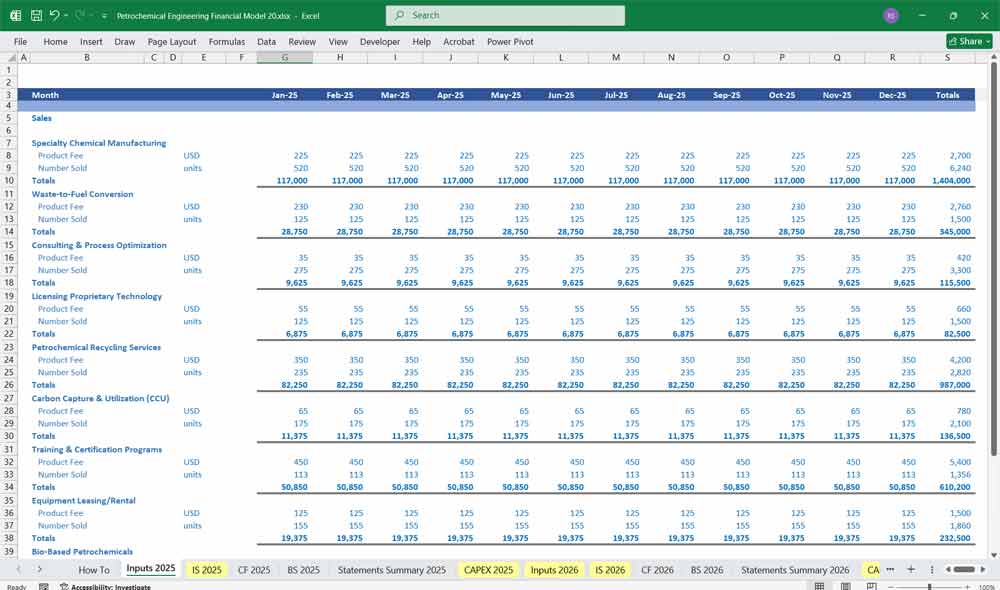
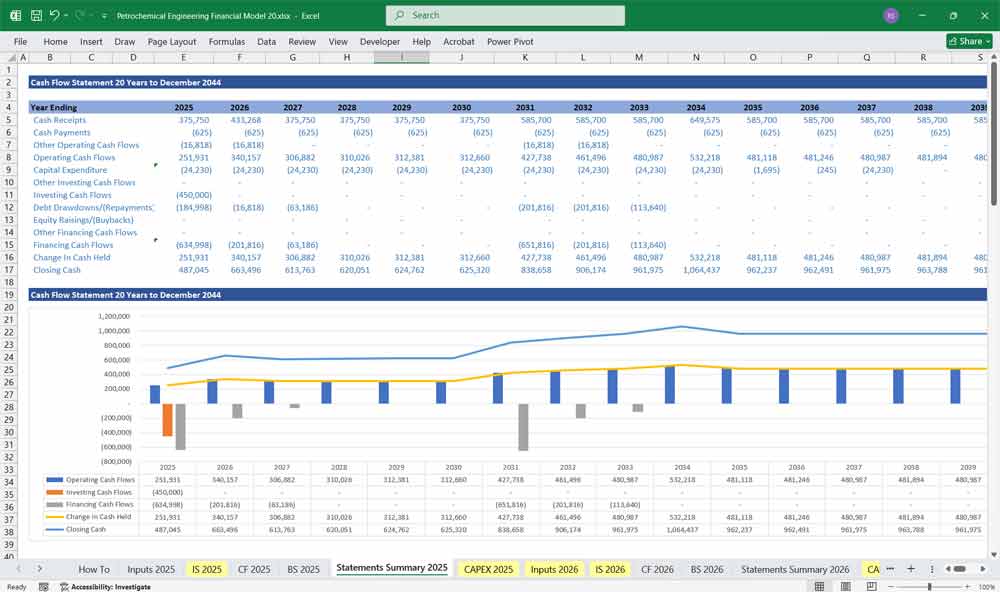
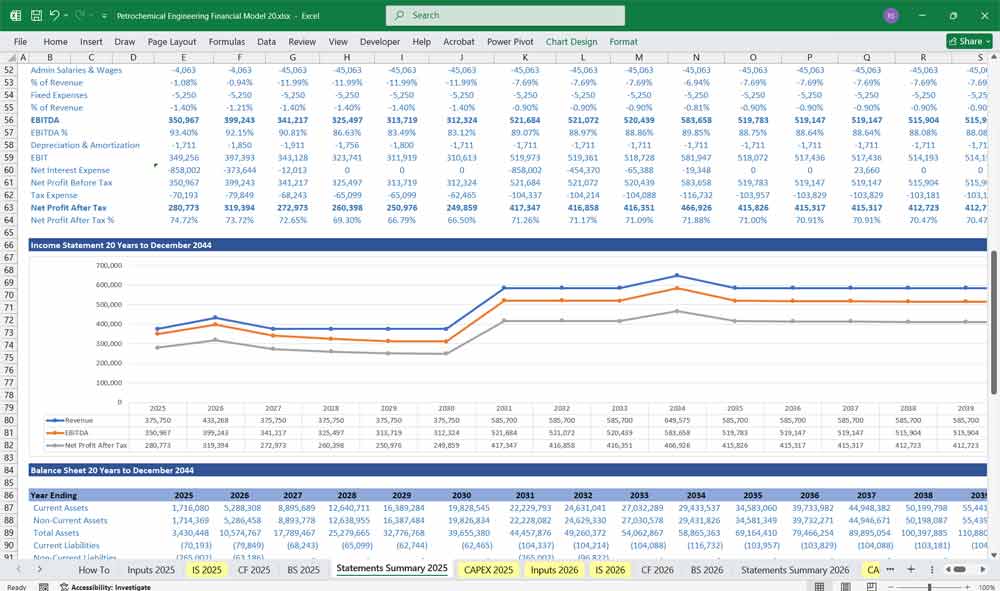
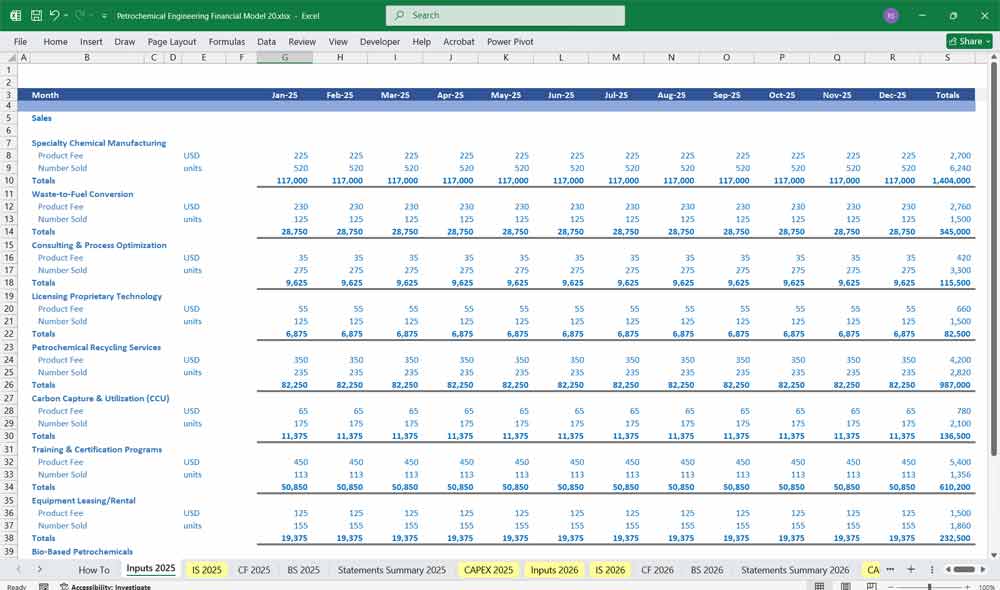
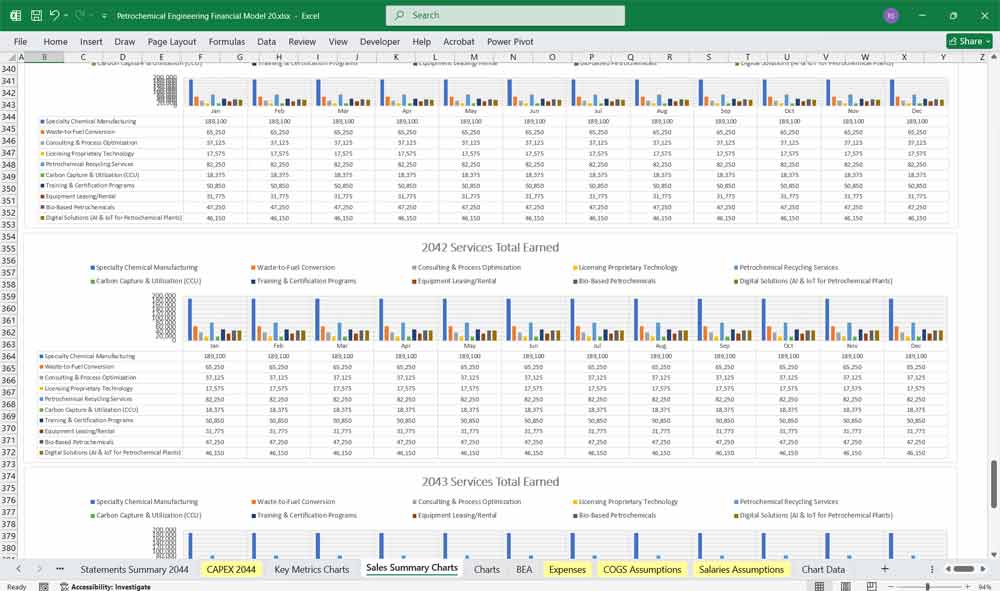

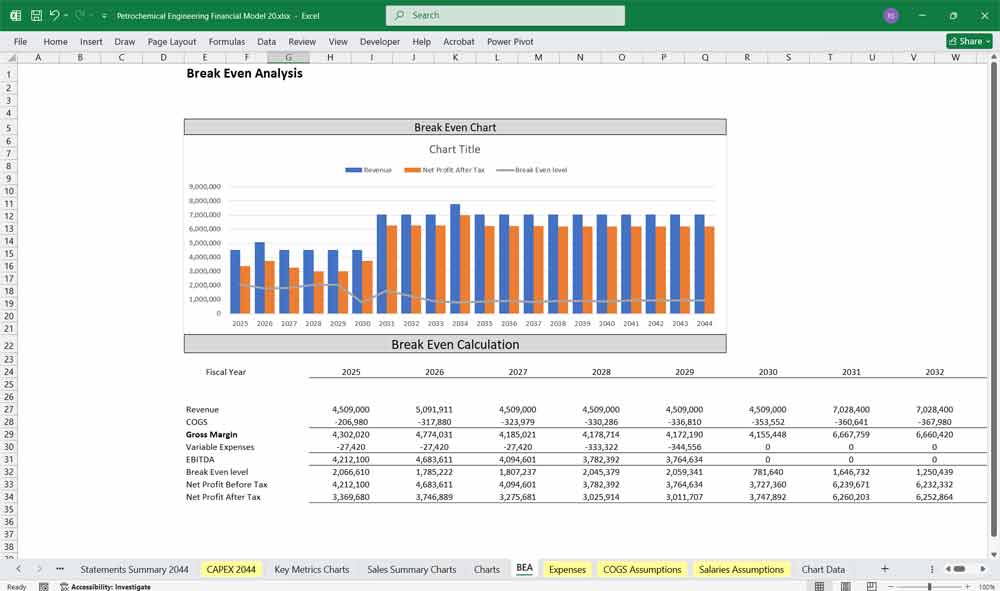

Sensitivity & Scenario Analysis On The Financial Model
Key Ratios and KPIs
Gross Margin, EBITDA Margin, Net Margin
Return on Equity (ROE), Return on Assets (ROA)
Debt/Equity, Interest Coverage
Cash Conversion Cycle
Capacity Utilization
Break-even Price per Metric Ton
Scenario and Sensitivity Analysis
Feedstock cost variation
Product price volatility
Project delay impacts
FX fluctuation scenarios
Regulatory change impact
Download Link On Next Page
